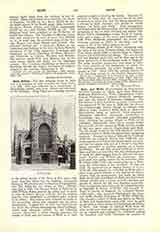

Bath Abbey.—The first religious house in Bath was a monastery of nuns founded by King Osric, A.D. 676. This was followed by a community of Benedictine monks, who were visited and reformed by St. Dunstan. King Edgar was solemnly crowned in the abbey church of St. Peter in 973, and a few years later the abbot was St. Elphege, afterwards Bishop of Winchester and Archbishop of Canterbury, who was killed by the Danes in 1012. Aelfsige, who died in 1087, was the last Abbot of Bath; for in 1088 William Rufus granted the abbey and its lands to John de Villula, Bishop of Wells, and the resident superior was henceforth a cathedral prior instead of an abbot. This bishop later restored its lands to the monastery, which was endowed also by other benefactors. A great fire, in 1137, destroyed nearly the whole city, greatly damaging the abbey buildings, which were promptly rebuilt. In the following century there was a warm dispute between the monks of Bath and the canons of Wells as to their respective rights in electing the bishop. Innocent IV decreed, in 1245, that the election should be held alternately in either city, that the bishop should have a throne in both churches and should be styled Bishop “of Bath and Wells“. This arrangement continued until the Reformation, and the subsequent occupants of the see have retained the double title. Henry VIII‘s Commission visited Bath in August, 1535, and a report of the usual type followed. In 1539 Prior Hollewell surrendered the house and revenues (valued at £617) to the king, and the monastic life of the abbey came to an end.
The present church of St. Peter, occupying only the nave of the great Norman fabric, was begun by Prior Birde, about 1500, to replace John de Villula’s church, which had fallen into decay. The new church was not finished until 1572, and is thus one of the latest specimens of Perpendicular work in England. The latest so-called restoration took place in 1874. No trace remains of the monastery, of which the last portion (probably the prior’s lodgings) disappeared in 1755. Since 1679 the Catholic mission of Bath has been served by the English Benedictines.
D. O. HUNTER-BLAIR.

